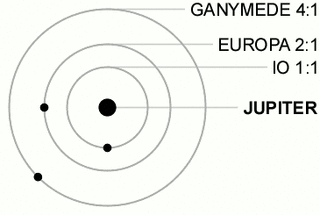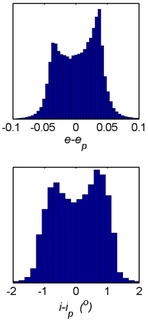Related Research Articles

In celestial mechanics, orbital resonance occurs when orbiting bodies exert regular, periodic gravitational influence on each other, usually because their orbital periods are related by a ratio of small integers. Most commonly, this relationship is found between a pair of objects. The physical principle behind orbital resonance is similar in concept to pushing a child on a swing, whereby the orbit and the swing both have a natural frequency, and the body doing the "pushing" will act in periodic repetition to have a cumulative effect on the motion. Orbital resonances greatly enhance the mutual gravitational influence of the bodies. In most cases, this results in an unstable interaction, in which the bodies exchange momentum and shift orbits until the resonance no longer exists. Under some circumstances, a resonant system can be self-correcting and thus stable. Examples are the 1:2:4 resonance of Jupiter's moons Ganymede, Europa and Io, and the 2:3 resonance between Pluto and Neptune. Unstable resonances with Saturn's inner moons give rise to gaps in the rings of Saturn. The special case of 1:1 resonance between bodies with similar orbital radii causes large solar system bodies to eject most other bodies sharing their orbits; this is part of the much more extensive process of clearing the neighbourhood, an effect that is used in the current definition of a planet.

A Kirkwood gap is a gap or dip in the distribution of the semi-major axes of the orbits of main-belt asteroids. They correspond to the locations of orbital resonances with Jupiter.
A V-type asteroid or Vestoid is an asteroid whose spectral type is that of 4 Vesta. Approximately 6% of main-belt asteroids are vestoids, with Vesta being by far the largest of them. They are relatively bright, and rather similar to the more common S-type asteroid, which are also made up of stony irons and ordinary chondrites, with V-types containing more pyroxene than S-types.
Planet V is a hypothetical fifth terrestrial planet posited by NASA scientists John Chambers and Jack J. Lissauer to have once existed between Mars and the asteroid belt. In their hypothesis the Late Heavy Bombardment of the Hadean era began after perturbations from the other terrestrial planets caused Planet V's orbit to cross into the asteroid belt. Chambers and Lissauer presented the results of initial tests of this hypothesis during the 33rd Lunar and Planetary Science Conference, held from March 11 through 15, 2002.
In astronomy, a resonant trans-Neptunian object is a trans-Neptunian object (TNO) in mean-motion orbital resonance with Neptune. The orbital periods of the resonant objects are in a simple integer relations with the period of Neptune, e.g. 1:2, 2:3, etc. Resonant TNOs can be either part of the main Kuiper belt population, or the more distant scattered disc population.

The proper orbital elements or proper elements of an orbit are constants of motion of an object in space that remain practically unchanged over an astronomically long timescale. The term is usually used to describe the three quantities:

In astronomy, an irregular moon, irregular satellite or irregular natural satellite is a natural satellite following a distant, inclined, and often eccentric and retrograde orbit. They have been captured by their parent planet, unlike regular satellites, which formed in orbit around them. Irregular moons have a stable orbit, unlike temporary satellites which often have similarly irregular orbits but will eventually depart. The term does not refer to shape as Triton is a round moon, but is considered irregular due to its orbit.
The Hungaria asteroids, also known as the Hungaria group, are a dynamical group of asteroids in the asteroid belt which orbit the Sun with a semi-major axis between 1.78 and 2.00 astronomical units (AU). They are the innermost dense concentration of asteroids in the Solar System—the near-Earth asteroids are much more sparse—and derive their name from their largest member 434 Hungaria. The Hungaria group includes the Hungaria family, a collisional asteroid family which dominates its population.
In general relativity, Lense–Thirring precession or the Lense–Thirring effect is a relativistic correction to the precession of a gyroscope near a large rotating mass such as the Earth. It is a gravitomagnetic frame-dragging effect. It is a prediction of general relativity consisting of secular precessions of the longitude of the ascending node and the argument of pericenter of a test particle freely orbiting a central spinning mass endowed with angular momentum .
1222 Tina, provisional designation 1932 LA, is a metallic asteroid and parent body of the Tina family located in the intermediate asteroid belt, approximately 25 kilometers in diameter. It was discovered on 11 June 1932, by Belgian astronomer Eugène Delporte at Uccle Observatory in Belgium. It was named after a friend of the discoverer.

The Nicemodel is a scenario for the dynamical evolution of the Solar System. It is named for the location of the Observatoire de la Côte d'Azur—where it was initially developed in 2005—in Nice, France. It proposes the migration of the giant planets from an initial compact configuration into their present positions, long after the dissipation of the initial protoplanetary disk. In this way, it differs from earlier models of the Solar System's formation. This planetary migration is used in dynamical simulations of the Solar System to explain historical events including the Late Heavy Bombardment of the inner Solar System, the formation of the Oort cloud, and the existence of populations of small Solar System bodies such as the Kuiper belt, the Neptune and Jupiter trojans, and the numerous resonant trans-Neptunian objects dominated by Neptune.
Nodal precession is the precession of the orbital plane of a satellite around the rotational axis of an astronomical body such as Earth. This precession is due to the non-spherical nature of a rotating body, which creates a non-uniform gravitational field. The following discussion relates to low Earth orbit of artificial satellites, which have no measurable effect on the motion of Earth. The nodal precession of more massive, natural satellites like the Moon is more complex.
The five-planet Nice model is a recent variation of the Nice model that begins with five giant planets, the four plus an additional ice giant in a chain of mean-motion resonances.
2012 FC71, also written 2012 FC71, is a small asteroid trapped in a Kozai resonance with the Earth.

The E-belt asteroids were the population of a hypothetical extension of the primordial asteroid belt proposed as the source of most of the basin-forming lunar impacts during the Late Heavy Bombardment.
The jumping-Jupiter scenario specifies an evolution of giant-planet migration described by the Nice model, in which an ice giant is scattered inward by Saturn and outward by Jupiter, causing their semi-major axes to jump, quickly separating their orbits. The jumping-Jupiter scenario was proposed by Ramon Brasser, Alessandro Morbidelli, Rodney Gomes, Kleomenis Tsiganis, and Harold Levison after their studies revealed that the smooth divergent migration of Jupiter and Saturn resulted in an inner Solar System significantly different from the current Solar System. During this migration secular resonances swept through the inner Solar System exciting the orbits of the terrestrial planets and the asteroids, leaving the planets' orbits too eccentric, and the asteroid belt with too many high-inclination objects. The jumps in the semi-major axes of Jupiter and Saturn described in the jumping-Jupiter scenario can allow these resonances to quickly cross the inner Solar System without altering orbits excessively, although the terrestrial planets remain sensitive to its passage.
The Nice 2 model is a model of the early evolution of the Solar System. The Nice 2 model resembles the original Nice model in that a late instability of the outer Solar System results in gravitational encounters between planets, the disruption of an outer planetesimal disk, and the migrations of the outer planets to new orbits. However, the Nice 2 model differs in its initial conditions and in the mechanism for triggering the late instability. These changes reflect the analysis of the orbital evolution of the outer Solar System during the gas disk phase and the inclusion of gravitational interactions between planetesimals in the outer disk into the model.

In planetary astronomy, the grand tack hypothesis proposes that Jupiter formed at 3.5 AU, then migrated inward to 1.5 AU, before reversing course due to capturing Saturn in an orbital resonance, eventually halting near its current orbit at 5.2 AU. The reversal of Jupiter's planetary migration is likened to the path of a sailboat changing directions (tacking) as it travels against the wind.
The hypothetical Planet Nine would modify the orbits of extreme trans-Neptunian objects via a combination of effects. On very long timescales exchanges of angular momentum with Planet Nine cause the perihelia of anti-aligned objects to rise until their precession reverses direction, maintaining their anti-alignment, and later fall, returning them to their original orbits. On shorter timescales mean-motion resonances with Planet Nine provides phase protection, which stabilizes their orbits by slightly altering the objects' semi-major axes, keeping their orbits synchronized with Planet Nine's and preventing close approaches. The inclination of Planet Nine's orbit weakens this protection, resulting in a chaotic variation of semi-major axes as objects hop between resonances. The orbital poles of the objects circle that of the Solar System's Laplace plane, which at large semi-major axes is warped toward the plane of Planet Nine's orbit, causing their poles to be clustered toward one side.
References
- ↑ Murray, Carl D. (2000-02-13). Solar system dynamics. Dermott, S. F. Cambridge. ISBN 0521572959. OCLC 40857034.
- ↑ V. Carruba, et al. (2005). "On the V-type asteroids outside the Vesta family". Astronomy & Astrophysics. 441 (2): 819. arXiv: astro-ph/0506656 . Bibcode:2005A&A...441..819C. doi:10.1051/0004-6361:20053355. S2CID 18658829.